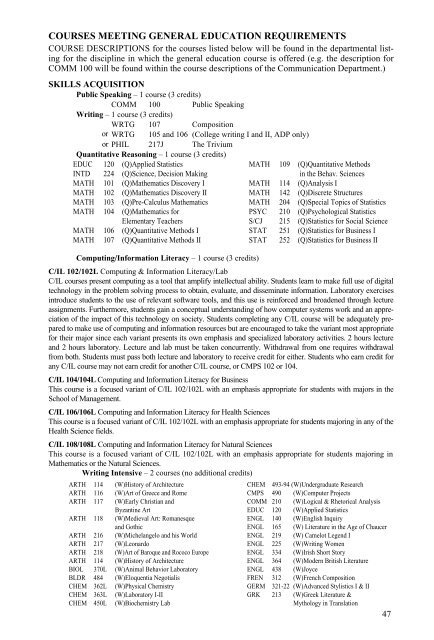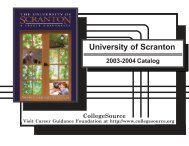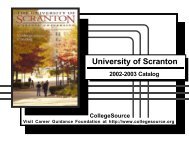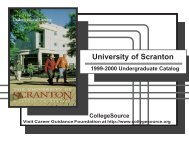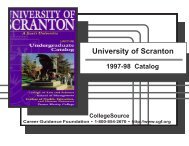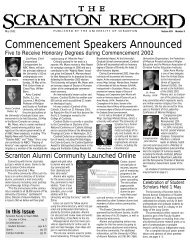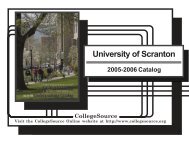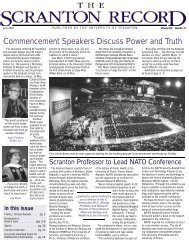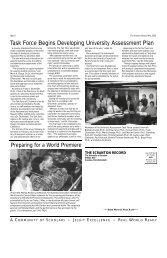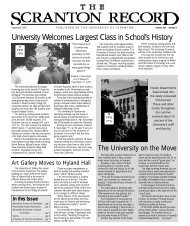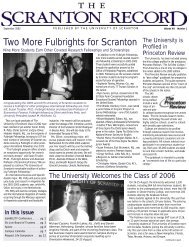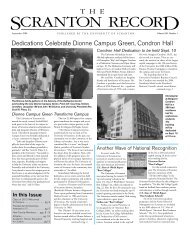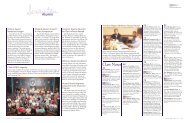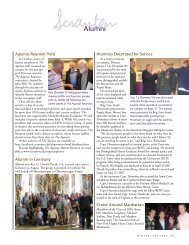You also want an ePaper? Increase the reach of your titles
YUMPU automatically turns print PDFs into web optimized ePapers that Google loves.
COURSES MEETING GENERAL EDUCATION REQUIREMENTS<br />
COURSE DESCRIPTIONS for the courses listed below will be found in the departmental listing<br />
for the discipline in which the general education course is <strong>of</strong>fered (e.g. the description for<br />
COMM 100 will be found within the course descriptions <strong>of</strong> the Communication Department.)<br />
SKILLS ACQUISITION<br />
Public Speaking – 1 course (3 credits)<br />
COMM 100 Public Speaking<br />
Writing – 1 course (3 credits)<br />
WRTG 107 Composition<br />
or WRTG 105 and 106 (College writing I and II, ADP only)<br />
or<br />
PHIL 217J <strong>The</strong> Trivium<br />
Quantitative Reasoning – 1 course (3 credits)<br />
EDUC 120 (Q)Applied Statistics<br />
INTD 224 (Q)Science, Decision Making<br />
MATH 101 (Q)Mathematics Discovery I<br />
MATH 102 (Q)Mathematics Discovery II<br />
MATH 103 (Q)Pre-Calculus Mathematics<br />
MATH 104 (Q)Mathematics for<br />
Elementary Teachers<br />
MATH 106 (Q)Quantitative Methods I<br />
MATH 107 (Q)Quantitative Methods II<br />
Computing/Information Literacy – 1 course (3 credits)<br />
C/IL 102/102L Computing & Information Literacy/Lab<br />
C/IL courses present computing as a tool that amplify intellectual ability. Students learn to make full use <strong>of</strong> digital<br />
technology in the problem solving process to obtain, evaluate, and disseminate information. Laboratory exercises<br />
introduce students to the use <strong>of</strong> relevant s<strong>of</strong>tware tools, and this use is reinforced and broadened through lecture<br />
assignments. Furthermore, students gain a conceptual understanding <strong>of</strong> how computer systems work and an appreciation<br />
<strong>of</strong> the impact <strong>of</strong> this technology on society. Students completing any C/IL course will be adequately prepared<br />
to make use <strong>of</strong> computing and information resources but are encouraged to take the variant most appropriate<br />
for their major since each variant presents its own emphasis and specialized laboratory activities. 2 hours lecture<br />
and 2 hours laboratory. Lecture and lab must be taken concurrently. Withdrawal from one requires withdrawal<br />
from both. Students must pass both lecture and laboratory to receive credit for either. Students who earn credit for<br />
any C/IL course may not earn credit for another C/IL course, or CMPS 102 or 104.<br />
C/IL 104/104L Computing and Information Literacy for Business<br />
This course is a focused variant <strong>of</strong> C/IL 102/102L with an emphasis appropriate for students with majors in the<br />
School <strong>of</strong> Management.<br />
C/IL 106/106L Computing and Information Literacy for Health Sciences<br />
This course is a focused variant <strong>of</strong> C/IL 102/102L with an emphasis appropriate for students majoring in any <strong>of</strong> the<br />
Health Science fields.<br />
C/IL 108/108L Computing and Information Literacy for Natural Sciences<br />
This course is a focused variant <strong>of</strong> C/IL 102/102L with an emphasis appropriate for students majoring in<br />
Mathematics or the Natural Sciences.<br />
Writing Intensive – 2 courses (no additional credits)<br />
ARTH 114 (W)History <strong>of</strong> Architecture<br />
ARTH 116 (W)Art <strong>of</strong> Greece and Rome<br />
ARTH 117 (W)Early Christian and<br />
Byzantine Art<br />
ARTH 118 (W)Medieval Art: Romanesque<br />
and Gothic<br />
ARTH 216 (W)Michelangelo and his World<br />
ARTH 217 (W)Leonardo<br />
ARTH 218 (W)Art <strong>of</strong> Baroque and Rococo Europe<br />
ARTH 114 (W)History <strong>of</strong> Architecture<br />
BIOL 370L (W)Animal Behavior Laboratory<br />
BLDR 484 (W)Eloquentia Negotialis<br />
CHEM 362L (W)Physical Chemistry<br />
CHEM 363L (W)Laboratory I-II<br />
CHEM 450L (W)Biochemistry Lab<br />
MATH 109 (Q)Quantitative Methods<br />
in the Behav. Sciences<br />
MATH 114 (Q)Analysis I<br />
MATH 142 (Q)Discrete Structures<br />
MATH 204 (Q)Special Topics <strong>of</strong> Statistics<br />
PSYC 210 (Q)Psychological Statistics<br />
S/CJ 215 (Q)Statistics for Social Science<br />
STAT 251 (Q)Statistics for Business I<br />
STAT 252 (Q)Statistics for Business II<br />
CHEM 493-94 (W)Undergraduate Research<br />
CMPS 490 (W)Computer Projects<br />
COMM 210 (W)Logical & Rhetorical Analysis<br />
EDUC 120 (W)Applied Statistics<br />
ENGL 140 (W)English Inquiry<br />
ENGL 165 (W) Literature in the Age <strong>of</strong> Chaucer<br />
ENGL 219 (W) Camelot Legend I<br />
ENGL 225 (W)Writing Women<br />
ENGL 334 (W)Irish Short Story<br />
ENGL 364 (W)Modern British Literature<br />
ENGL 438 (W)Joyce<br />
FREN 312 (W)French Composition<br />
GERM 321-22 (W)Advanced Stylistics I & II<br />
GRK 213 (W)Greek Literature &<br />
Mythology in Translation<br />
47


